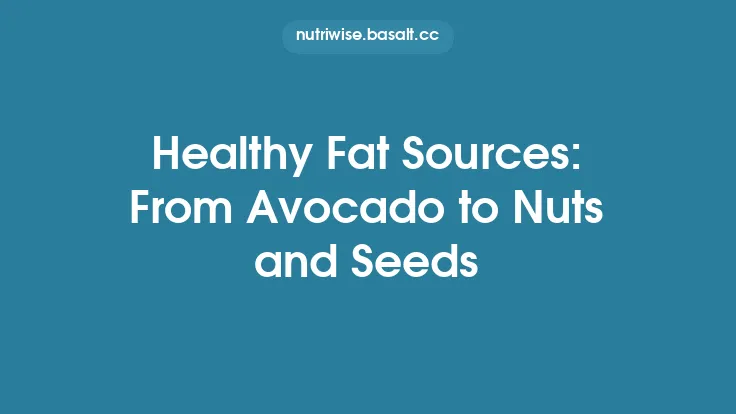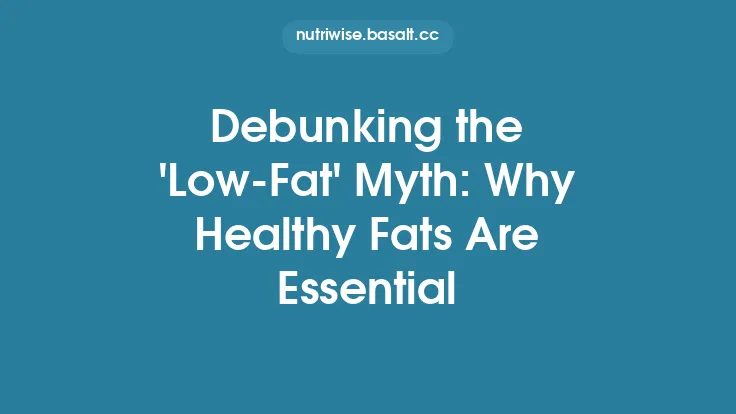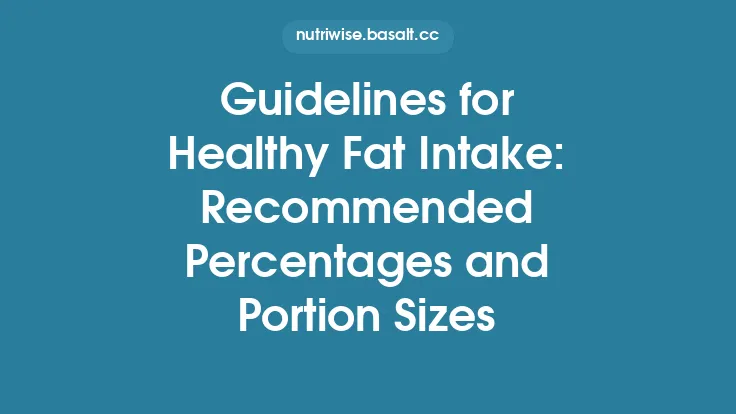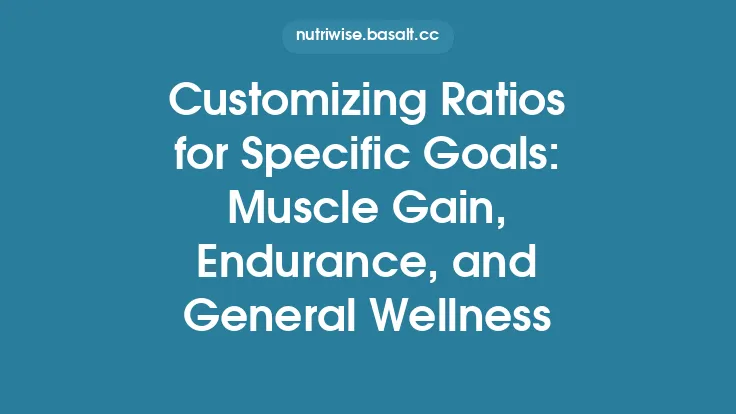Whole‑food fats have been a cornerstone of traditional diets around the world for millennia, yet modern nutrition advice often reduces fat to a single macronutrient to be counted or avoided. When we step back from the reductionist view and consider fats as part of whole foods—nuts, seeds, avocados, olives, fatty fish, dairy, eggs, and even certain cuts of meat—we begin to see a richer picture of how these lipids support long‑term wellness. This article explores the practical, science‑backed ways to incorporate a variety of whole‑food fats into everyday eating patterns, emphasizing balance, nutrient synergy, and sustainable habits that stand the test of time.
Why Whole‑Food Fats Matter for Longevity
Whole‑food fats deliver more than just calories. They are carriers for fat‑soluble vitamins (A, D, E, K), phytochemicals, and bioactive compounds that are often lost in refined or isolated fat products. The food matrix—the complex interaction of nutrients, fiber, and bioactive substances within a whole food—enhances the absorption and utilization of these components. For example, the lutein in avocado skin, the polyphenols in olives, and the selenium in Brazil nuts are all more bioavailable when consumed within their natural food context.
Long‑term observational studies consistently link diets rich in whole‑food fats with lower rates of age‑related chronic conditions, including neurodegenerative decline, metabolic dysregulation, and certain cancers. While the exact mechanisms are multifactorial, the combination of sustained energy provision, support for cellular membranes, and the presence of antioxidant compounds creates an environment conducive to healthy aging.
Key Whole‑Food Fat Sources and Their Nutrient Profiles
| Whole Food | Typical Serving (≈) | Notable Nutrients Beyond Fat |
|---|---|---|
| Avocado | ½ medium fruit | Potassium, folate, lutein |
| Almonds | ¼ cup (≈23 nuts) | Vitamin E, magnesium, fiber |
| Walnuts | ¼ cup | Alpha‑linolenic acid (plant‑derived), copper |
| Olives (green or black) | 10 olives | Polyphenols, iron |
| Fatty fish (e.g., salmon, sardines) | 3 oz cooked | Vitamin D, selenium, iodine |
| Eggs (whole, pastured) | 1 large | Choline, vitamin B12, lutein |
| Full‑fat dairy (yogurt, cheese) | ½ cup yogurt, 1 oz cheese | Calcium, vitamin K2, probiotics (in fermented forms) |
| Coconut meat (fresh) | ½ cup shredded | Medium‑chain triglycerides, manganese |
| Seeds (chia, flax, pumpkin) | 2 Tbsp | Fiber, magnesium, zinc |
Each of these foods supplies a unique blend of micronutrients and bioactives that complement the lipid component, reinforcing the idea that the health impact of a fat source cannot be fully understood in isolation.
Creating a Balanced Fat Palette: Animal vs. Plant Sources
A truly balanced approach does not pit animal fats against plant fats; rather, it weaves them together to capture the strengths of each. Animal‑derived whole‑food fats often come paired with high‑quality protein and a suite of micronutrients that are less abundant in plant sources (e.g., vitamin B12, heme iron, certain forms of vitamin D). Plant‑derived fats, on the other hand, bring fiber, phytochemicals, and a broader spectrum of minerals.
Practical balancing tips
- Rotate protein‑fat pairings – Alternate meals featuring fish or eggs with those centered on legumes, nuts, or seeds. This rotation ensures exposure to a wide array of nutrients.
- Include at least one plant‑based fat daily – A handful of nuts, a spoonful of seed butter, or a slice of avocado can provide a distinct nutrient set that complements animal‑based meals.
- Mind the cooking method – While the focus here is not on oil stability, using whole‑food fats in their natural form (e.g., roasting vegetables with olive halves, adding avocado to salads) preserves their inherent nutrient matrix.
Integrating Whole‑Food Fats into Daily Meals
Breakfast
- Top Greek yogurt with a mix of chopped walnuts, pumpkin seeds, and a drizzle of fresh avocado puree.
- Scramble pastured eggs with sautéed spinach and a side of sliced olives.
Lunch
- Build a grain bowl with quinoa, roasted sweet potatoes, a generous scoop of black beans, and a topping of sliced avocado and toasted almonds.
- Pair a mixed greens salad with smoked salmon, cucumber ribbons, and a handful of sunflower seeds.
Snack
- Enjoy a small portion of cheese with a few whole‑grain crackers and a few olives.
- Blend a smoothie with full‑fat coconut milk, frozen berries, and a spoonful of chia seeds.
Dinner
- Grill a piece of fatty fish and serve it alongside roasted Brussels sprouts tossed in whole‑olive halves.
- Prepare a vegetable stir‑fry using diced tofu, a medley of bell peppers, and a garnish of toasted sesame seeds.
By anchoring each meal with at least one whole‑food fat source, you naturally distribute lipid intake throughout the day, supporting steady energy levels and satiety.
Mindful Consumption: Satiety, Energy Balance, and Portion Awareness
Whole‑food fats are energy‑dense, but their satiety‑inducing properties often lead to lower overall caloric intake when consumed mindfully. The combination of fat with fiber (as found in nuts, seeds, and avocado) slows gastric emptying, prolongs the feeling of fullness, and helps stabilize blood glucose without the need for precise percentage calculations.
Guidelines for intuitive portioning
- Visual cues – A thumb‑size portion of nut butter, a quarter‑avocado, or a small handful of nuts roughly equates to 2–3 Tbsp of fat.
- Pre‑portion snacks – Portion nuts or seeds into small containers to avoid mindless over‑eating.
- Listen to hunger signals – Allow the natural satiety response to guide when you stop eating, rather than adhering to rigid serving sizes.
Synergy with Other Macronutrients: Fats, Carbs, and Proteins
Whole‑food fats do not operate in a vacuum; they interact dynamically with carbohydrates and proteins to influence digestion, nutrient absorption, and metabolic signaling.
- Fat‑enhanced carbohydrate absorption – Adding a modest amount of avocado to a carbohydrate‑rich meal (e.g., a grain bowl) can improve the uptake of fat‑soluble vitamins present in the dish.
- Protein‑fat pairing for muscle maintenance – Consuming eggs or fish (protein + whole‑food fat) supports muscle protein synthesis more effectively than protein alone, especially in older adults.
- Balancing glycemic response – The presence of fat in a meal blunts rapid glucose spikes, contributing to smoother energy curves throughout the day.
Gut Health and the Role of Whole‑Food Fats
The gut microbiome thrives on a diverse diet, and whole‑food fats contribute both directly and indirectly to microbial balance.
- Prebiotic fibers in fat‑rich foods – Many nuts, seeds, and avocados contain soluble fiber that serves as a substrate for beneficial bacteria.
- Bioactive lipids – Certain fatty acids in whole foods act as signaling molecules that can modulate inflammation within the gut lining.
- Fermented fat sources – Full‑fat yogurts and cheeses introduce probiotic cultures, further enriching the microbial ecosystem.
A gut environment supported by these mechanisms can improve nutrient extraction, immune regulation, and even mood stability.
Sustainability and Ethical Considerations in Fat Choices
Long‑term wellness extends beyond personal health to planetary health. Selecting whole‑food fats with an eye toward sustainability can amplify the benefits of a balanced diet.
- Plant‑based fats – Nuts, seeds, and avocados generally have lower greenhouse gas footprints per gram of fat compared with many animal sources.
- Regenerative animal farming – When choosing animal‑derived fats, prioritize products from farms that practice rotational grazing, biodiversity preservation, and humane animal welfare.
- Seasonality and locality – Opt for locally grown nuts or regionally harvested fish to reduce transportation emissions and support local economies.
By aligning personal nutrition with environmental stewardship, you reinforce a holistic model of wellness.
Practical Tips for Long‑Term Success
- Create a “fat pantry” – Keep a rotating stock of nuts, seeds, olives, and quality dairy so that whole‑food fats are always on hand.
- Batch‑prepare – Roast a tray of mixed nuts and seeds with herbs for quick snack portions; pre‑slice avocado or store it with lemon juice to prevent browning.
- Use visual reminders – Place a small bowl of olives on the kitchen counter as a cue to add a fat source to meals.
- Track satisfaction, not numbers – Keep a simple journal noting how full and energized you feel after meals that include whole‑food fats; this reinforces intuitive eating habits.
- Educate your palate – Experiment with lesser‑known fats such as macadamia nuts, hemp seeds, or fermented goat cheese to keep the diet interesting and nutritionally varied.
Common Misconceptions to Avoid
- “All fats are the same” – While the article avoids deep classification, it’s important to recognize that the food matrix influences how fats behave in the body. Whole‑food fats differ markedly from isolated oil or butter in nutrient composition.
- “If a food is high in fat, it must be avoided” – Whole‑food fats often come with protective compounds that mitigate potential downsides seen in refined fats.
- “You need to count every gram of fat” – For most individuals, focusing on the quality and variety of whole‑food fat sources yields better health outcomes than meticulous gram‑by‑gram tracking.
By dispelling these myths, you can adopt a more relaxed, evidence‑based relationship with dietary fats.
Incorporating a diverse array of whole‑food fats into daily eating patterns offers a robust foundation for long‑term wellness. The synergy of lipids with vitamins, minerals, fiber, and bioactive compounds creates a nutrient package that supports energy stability, satiety, gut health, and overall vitality. By rotating animal and plant sources, listening to internal cues, and aligning choices with sustainable practices, you can build a resilient, enjoyable dietary pattern that stands the test of time.





